Nickname(s) White Death Unit Infantry Regiment 34 Height 1.6 m | Years of service 1925–1940 Role Marksman Allegiance Finland Name Simo Hayha | |
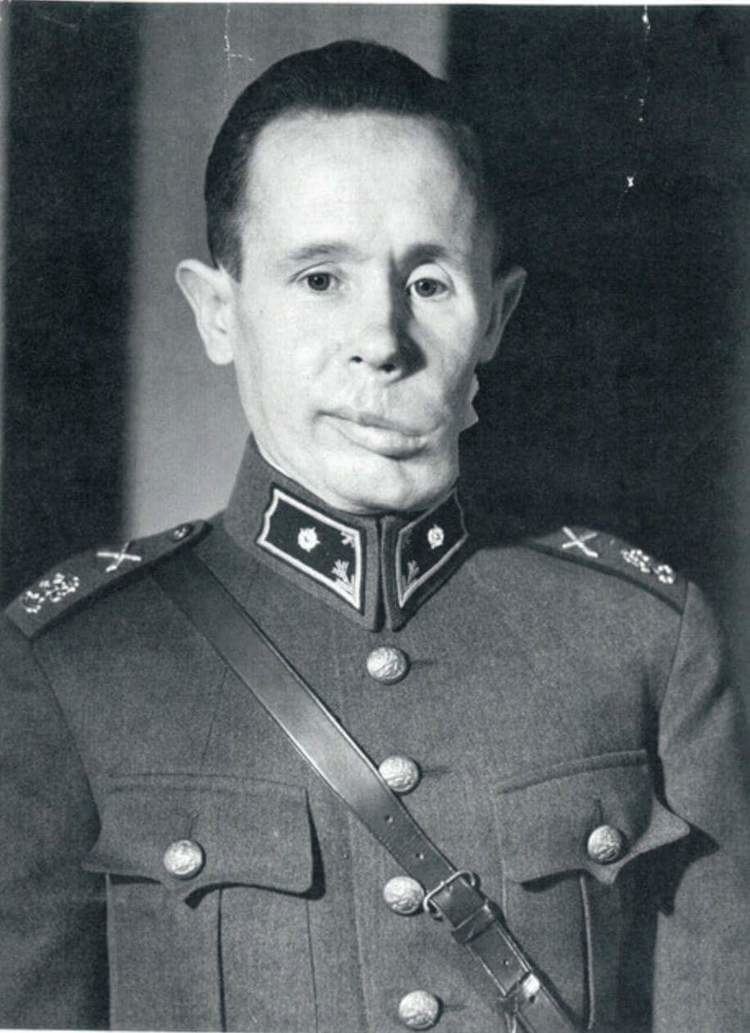 | ||
Rank alikersantti (Corporal) during the Winter War, promoted to Vanrikki (Second Lieutenant) shortly afterward Parents Katriina Hayha, Juho Hayha Similar People Chris Kyle, Vasily Zaytsev, Carlos Hathcock, Lyudmila Pavlichenko, Erwin Konig Died 1 April 2002 (aged 96) Hamina, Finland | ||
5 badass facts of simo h yh
Simo "Simuna" Häyhä ([ˈsimɔ ˈhæy̯hæ]; 17 December 1905 – 1 April 2002), nicknamed "White Death" (Russian: Белая смерть, Belaya Smert; Finnish: valkoinen kuolema; Swedish: den vita döden) by the Red Army, was a Finnish marksman. Using a Finnish-produced M/28-30 rifle (a variant of the Mosin–Nagant rifle) and the Suomi KP/-31 submachine gun, he is reported as having killed 505 men during the 1939–40 Winter War, the highest recorded number of confirmed sniper kills in any major war.
Contents
- 5 badass facts of simo h yh
- Simo h yh the white death history abridged
- Early life
- Winter War service
- Later life
- Cultural depictions
- References
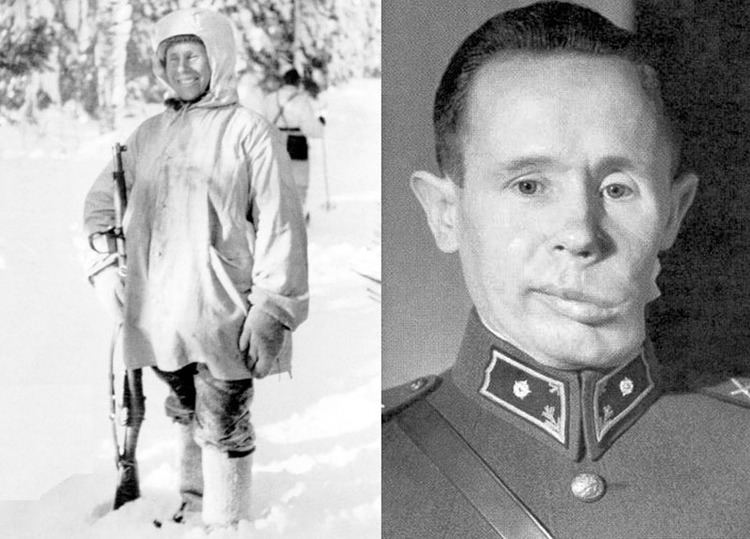
Simo h yh the white death history abridged
Early life

Häyhä was born in the municipality of Rautjärvi in the Grand Duchy of Finland, in present-day southern Finland near the border with Russia, and started his military service in 1925. Before entering combat, Häyhä was a farmer and hunter. At the age of 20, he joined the Finnish voluntary militia White Guard (Suojeluskunta) and was also successful in shooting sports in competitions in the Viipuri Province. His home was reportedly full of trophies for marksmanship.
Winter War service
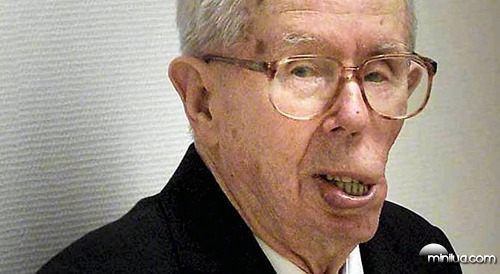
During the 1939–40 Winter War between Finland and the Soviet Union, Häyhä served as a sniper for the Finnish Army against the Red Army in the 6th Company of JR 34 during the Battle of Kollaa in temperatures between −40 °C (−40 °F) and −20 °C (−4 °F), dressed completely in white camouflage. Because of Joseph Stalin’s purges of military experts in the late 1930s, the Red Army was highly disorganised and Soviet troops were not issued with white camouflage suits for most of the war, making them easily visible to snipers in winter conditions. Häyhä has been credited with 505 confirmed sniper kills. A daily account of the kills at Kollaa was made for the Finnish snipers. However, he was also known to carry and use a submachine gun, and though very few of his kills using this weapon were confirmed, as such, the true count is thought to be much higher, more than likely around 800 kills. All of Häyhä's kills were accomplished in fewer than 100 days – an average of just over five per day – at a time of year with very few daylight hours.
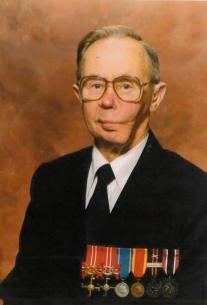
Häyhä used an M/28-30 with serial number 60974, because it suited his small frame of only 1.60 m (5 ft 3 in). The rifle is a shorter, Finnish White Guard militia variant of the Mosin–Nagant rifle, known as "Pystykorva" (literally "The spitz", due to the front sight's resemblance to the head of a spitz-type dog) chambered in the Finnish Mosin–Nagant cartridge 7.62×53R. He preferred iron sights over telescopic sights as to present a smaller target for the enemy (a sniper must raise his head higher when using a telescopic sight), to increase accuracy (a telescopic sight's glass can fog up easily in cold weather), and to aid in concealment (sunlight glare in telescopic sight lenses can reveal a sniper's position). As well as these tactics, he frequently packed dense mounds of snow in front of his position to conceal himself, provide padding for his rifle and reduce the characteristic puff of snow stirred up by the muzzle blast. He was also known to keep snow in his mouth whilst sniping, to prevent steamy breaths giving away his position in the cold air.
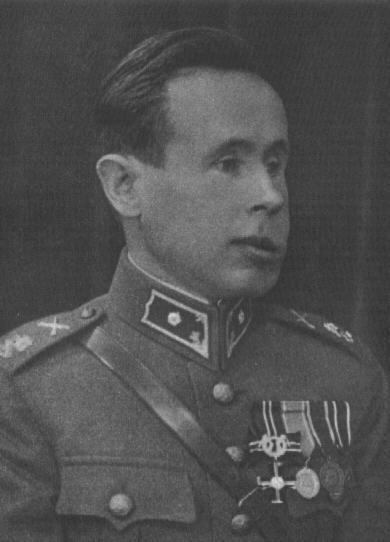
In their efforts to kill Häyhä, the Soviets used counter-snipers and artillery strikes, and on 6 March 1940, Häyhä was hit in his lower left jaw by an explosive bullet fired by a Red Army soldier. He was picked up by fellow soldiers who said "half his face was missing", but he did not die, regaining consciousness on 13 March, the day peace was declared. Shortly after the war, Häyhä was promoted from Alikersantti (Corporal) to vänrikki (Second lieutenant) by Finnish Field Marshal Carl Gustaf Emil Mannerheim.
Later life
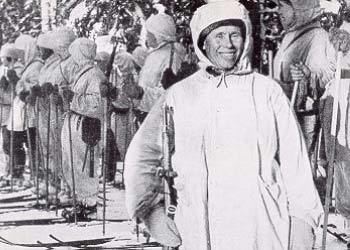
It took several years for Häyhä to recuperate from his wound. The bullet had crushed his jaw and blown off his left cheek. Nonetheless, he made a full recovery and became a successful moose hunter and dog breeder after World War II, and even hunted with the Finnish President Urho Kekkonen.
When asked in 1998 how he had become such a good shot, Häyhä answered, "Practice." When asked if he regretted killing so many people, he said, "I only did my duty, and what I was told to do, as well as I could." Simo Häyhä spent his last years in Ruokolahti, a small municipality located in southeastern Finland, near the Russian border. Simo Häyhä died in a war veterans' nursing home in Hamina in 2002 at the age of 96, and was buried in Ruokolahti.
Cultural depictions
Simo Häyhä was the inspiration for "White Death," a song from the album Coat of Arms of Swedish power metal band Sabaton.
